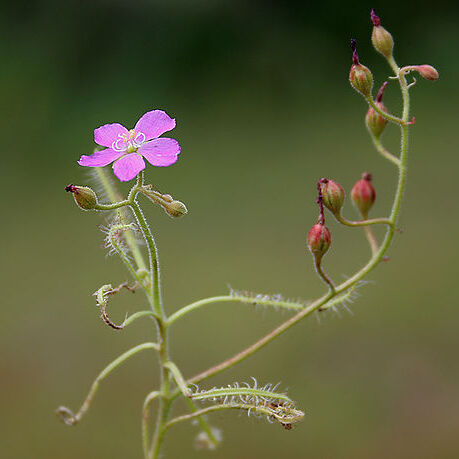Slender annual, delicate, caulescent herbs forming a few roots. Stems thin, erect or matted. Leaves cauline apetiolate, exstipulate, with circinnate vernation, patent, erect, reflexed with age; lamina linear to filiform, 2-10 cm long, 0.5-3 mm broad, apex long acuminate, margins densely studded with long tentacles bearing knob-shaped glands, these absent near the base. Inflorescences several to a stem, axillary, patent-recurved, with 3-20 flowers on upper side, scape short, rhachis elongating during flowering and fruiting, up to 15 cm long; bracts appressed to the rhachis, small; pedicels up to 2 cm in fruit; flowers small. Calyx-lobes 2.5 mm long. Petals cuneate-obovate c. 6 mm long, pink to mauve. Stamens with thin filiform filaments. Styles divided from the base, with dilated, erect, stigmatic apices. Capsule broadly oblong, 2 mm in diam., seeds globose-ellipsoid, 0.4 mm, coarsely reticulate, black, apiculate. Flowering during the summer months.
Caulescent annual.. Stem 3–50 cm. long, glandular-pubescent, leafy.. Leaves spirally arranged; blade linear, 10–100 mm. long, 0.5–3 mm. broad, glandular; petiole 1–15 mm. long, glandular-pubescent.. Stipules absent.. Peduncles lateral, usually extra-axillary, 5–150 mm. long, glandular-pubescent; inflorescence 3–20-flowered; pedicels 3–20 mm. long, glandular-pubescent.. Sepals 5, ± lanceolate, 3–5 mm. long, 1.0–1.5 mm. broad, glandular-pubescent.. Petals 5, obovate, 6–8 mm. long, 3–6 mm. broad, pink to purple.. Stamens 5, 3–4 mm. long.. Ovary subglobose; styles 3, bifid nearly to the base.. Seeds ovoid, apiculate, 0.4–0.5 mm. long, 0.3 mm. broad; testa reticulate with longitudinal and transverse ridges.. Fig. 1/11.
Stem flexile, slightly compressed, short glandular-hairy, 5-30 cm. Lower leaves recurved, often as stiltroots supporting the stem, central leaves spreading, upper ones erect, linear, light-green, petiole 1-15 mm; blade with tentacles, 2-11 cm by 0.5-3 mm. Stipules absent. Inflorescences lateral, mostly extra-axillary, spreading or arching, glandular-hairy, 3-20-flowered; peduncle 0.5-5½ cm; rhachis 3-15 cm. Bracts minute, linear. Pedicels ¾ cm, in fruit to 2 cm long. Sepals lanceolate, acute, 3-5 mm long. Petals obovate, ¾-1 cm long, pink to pale-purple. Anthers hastate. Styles 3, from the base divided into 2 thickened, simple ascendent arms. Capsule broadly oblong. Seeds apiculate, nigrescent, scrobiculate.
A small herb. It can be 30-50 cm tall. It can be erect or trailing. It grows as an annual. The leaves are long and thin. They are yellowish green and the edges are sometimes rolled inwards. They have sticky hairs. Leaves are 5-12 cm long. The flowers are white or pink. They are 2 cm across. The fruit is a capsule.
A slender, delicate, caulescent annual herb. Leaves linear, laxly arranged on stems. Inflorescence up to 150 mm long. Flowers mauve.
Leaves alternate; lamina 1–10 x 0·05–0·3 cm., linear, glandular; petioles 0·1–1·5 cm. long, glandular-pubescent; stipules absent.
Seeds 0·4–0·5 x 0·3 mm., black, ovoid, apiculate; testa with longitudinal and transverse ridges.
Peduncles lateral, usually extra-axillary, 0·5–15 cm. long, glandular-pubescent.
Inflorescence 3–20-flowered; pedicels 0·3–2 cm. long, glandular-pubescent.
Annual herb, caulescent, stem 3–50 cm., glandular-pubescent, foliose.
Sepals 5, 3–5 x l–1·5 mm., ± lanceolate, glandular-pubescent.
Ovary subglobose, glabrous; styles 3, 2-partite to the base.
Petals 5, 6–8 x 3–6 mm., obovate, pink to purple.
The commonest species in W. Africa.
Stamens 5, filaments 3–4 mm. long.
Flowers pink, mauve or white


